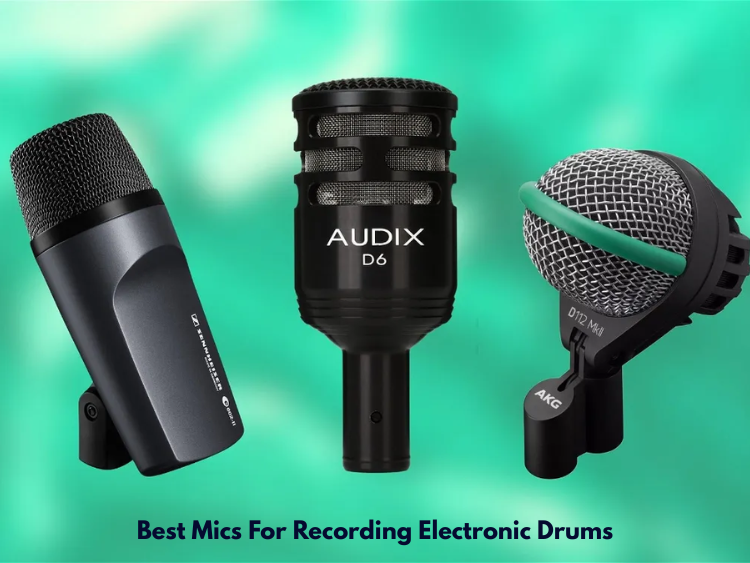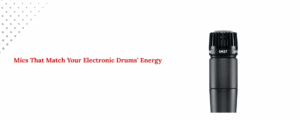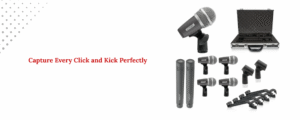Achieving the perfect sound with electronic drums however is not only dependent on the module or VSTs you use but also the way you record the performance. Although electronic kits need not be miked up in the conventional sense of drum miking, external microphones may be used to take your arrangement to the next level as you mix acoustic sounds or record a lively room dimension or record vocals, and other instruments at the same time. In this guide, we will learn how to choose the best mics that record electronic drums, and options thereof, hybrid setups, live streaming, and studio-like styles of production.
Why Mic’ing Electronic Drums Still Matters
A lot of electronic drum kits have trigger pads built in that send MIDI data or audio signals straight to your DAW (Digital Audio Workstation) or drum module. However, a lot of drummers still choose to mic their kits, especially when they film live shows, background noise, or mixed kits that have both acoustic and computer parts.
When you use mics, you can:
- Capture stick articulation and impact for added realism.
- In a live setting, add background noise or crowd sound
- Mix direct signals with mic signals from around the room to get a fuller sound
Choosing the Right Stereo Mics for Dance Music
Here are some things you should think about before you look at the best mics:
1. Frequency Response
A lot of different sounds can be heard in drums. Hi-hats and cymbals require microphones with excellent high-frequency response.
2. Durability
The beat of the drums is intense. Electronic drums are not very loud enough as the real drums, your mic must be able to withstand shaking, moving and random knocks.
3. Directionality
The cardioid mics are most appropriate with close speakers since it aims at the speaker and does not allow other noise.
4. Compatibility
Ensure it can be simple to connect your mic to audio interface or mixer. The majority of industrial equipment is XLR input.
Best Mics for Recording Electronic Drums
There is a good mix of price, quality, and performance in these mics that you can use to record computer drums.
1. Shure SM57: Standard in the Business
One of the best dynamic mics on the market is the Shure SM57. People usually record snare drums and guitar amps with it, but it also works great for recording stick hits on rubber or mesh pads. With its cardioid design, it separates every pad and the device is long-lasting hence may be applied in drum sets.
- Pros: Cheap, long-lasting, and great for isolation
- Best for: Snare and tom pads
2. Audio-Technica AT2020: For Extra Costs
The AT2020 is a big diaphragm condenser mic that won’t break the bank and is great for recording sound overheads. When you want to add cymbal pads, ambient sounds, or trigger modules with built-in audio, overheads can help. But you don’t always need them for electronic drums.
- Pros: Clear high-frequency response and good stereo image
- Best for: Overhead drum beats or background music
3. 5 Core Drum Microphone Kit – The Best Multi-Mic Pack for the Money
There is a great deal on the 5 Core Drum Microphone Kit if you want an all-in-one mic for your drum kit. There are several dynamic mics for kick, toms, snare, and overheads. They are all made to handle high sound pressure levels and give a smooth sound.
- Includes 7 mics for kick, bass, tom, snare, and cymbals
- High-quality dynamic microphones for clear sound
- Large diaphragm mic specially for bass drum
- Easy to set up with standard XLR connectors and mounts
- Durable all-metal build with strong grills
- Comes with a professional carrying case
- Compatible with most audio systems
Pros: It is a full kit, it will stand up to beatings and the response is tuned to drums
Best for: Getting a full kit on a budget
4. Sennheiser e604: Small and Clean
For toms and snares, these clip-on dynamic mics work great. Their sound is very clear and focused, which makes it easy to separate different drum pads. The clip-on form also saves room, which is great for studios or live shows that aren’t very big.
- Pros: Good separation, small size, and a clip-on design
- Best for: Tom and snare pads
5. RØDE NT1-A: Studio-Grade Clarity
The RØDE NT1-A is the best choice if you want to record the subtle stick work or room tones in great detail. It’s one of the quietest condenser mics out there, and you can also use it as a voice mic. Because it’s so sensitive, it’s not great for close mics, but it works great as a room mic or stereo pair.
- Pros: Very little noise and sound sharpness
- Best for: Room mics or recording background noise
Conclusion
With electronic drums, you do not need to depend entirely on what comes out of the module during recording. You can get a more realistic sound and more control during post-production with the proper mics especially when you want to create a studio-like environment, or developing a home studio. 5 Core Drum Microphone Kit is a good option to buy as an entry-level device or a kit full of value. It has a number of specialized mics that come at a very low cost. Make adjustments or adaptations to the mic positions and mixes, angles, etc. Good recordings are caused by good equipments as well as understanding how to use the equipments.




